urinary incontinence
Female urinary incontinence is a condition in which a woman involuntarily loses urine.
This loss can be mild, such as a few drops, or severe, such as complete loss of bladder control.

The causes of female urinary incontinence can be diverse, but some of the most common include:
- Weakness of the pelvic floor muscles, which can become weaker with pregnancy, vaginal delivery, menopause, obesity, or age.
- Damage to the nerves that control the bladder and pelvic floor muscles, which can be caused by injury, diseases such as diabetes, or surgery.
- Problems with the structure of the bladder or urethra, such as urethral obstruction or pelvic organ prolapse.
Risk factors for female urinary incontinence include:
- Advanced age.
- Obesity.
- Menopause.
- Pregnancy.
- Vaginal birth.
- Family history of urinary incontinence.
The treatments Treatments for female urinary incontinence vary depending on the cause and severity of the condition, but some common treatments include:
- Emsella: It consists of a chair that emits electromagnetic waves that stimulate the pelvic floor muscles, which can help strengthen them and improve urinary incontinence.
- Exercise therapy to strengthen the pelvic floor muscles, such as Kegel exercises.
- Bladder support devices, such as vaginal rings.
- Medications that reduce involuntary bladder contraction, such as anticholinergics.
- Surgery to correct structural problems of the bladder or urethra.
- Behavioral therapy, such as bladder training behavioral therapy.




